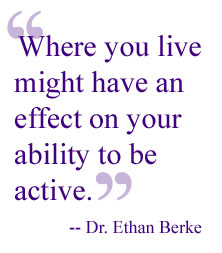
For Release: February 9, 2007
Contact: DMS Communications 603-650-1492
Pedestrian-Friendly Communities Make for More Active Older Adults
HANOVER, NH—Build it, and they will walk. That's the message from a new study that suggests communities that make it easy for senior citizens to walk will end up with more active residents.

Dr. Ethan Berke
The researchers weren't able to determine if "walkable" communities also translate to fewer fat people. But the findings still will be useful for planners and others who want to create better neighborhoods, said lead author Dr. Ethan Berke, assistant professor of community and family medicine at Dartmouth Medical School.
"What this says is that where you live might have an effect on your ability to be active," Berke said. "I can't go as far as to say that walkability [relates to] obesity or causes you to be more or less active, but this is a study that at least discovers an association."
Berke, a family physician, said he's long suspected that obesity is caused by more than just one's person's choices. Other factors play a role, including "the influence of environment and where people live on their ability to be active and [take part in] activities."
To get a handle on the effects of neighborhood design, Berke and a team of University of Washington (UW) urban planning specialists created a measurement of neighborhood "walkability" and applied it to communities in the Seattle region. Berke was also at UW before joining DMS in 2006.

The study findings appear in the March issue of the American Journal of Public Health.
The measurement looked at about 200 factors, including slope of the land, mix of residents and businesses and proximity to grocery stores.
The concept of walkability is "more than just being near a hiking trail or bicycle trail," Berke said. "It's having an opportunity to walk to places you'd have to go to anyway -- a school, bank, post office or restaurant."
The researchers then looked at the results of a survey of 936 people, ages 65 to 97, to see how the walkability scores of their neighborhoods affected their lives. Men living in more walkable neighborhoods were about six times more likely to walk for exercise, and women were 75 percent more likely to walk for exercise.
-DMS-
Story by Randy Dotinga, Contributing Writer, Health Behavior News Service (www.cfah.org). Used with permission.